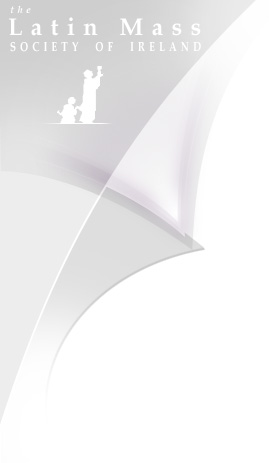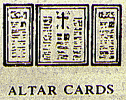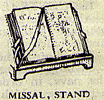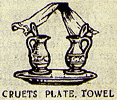
THE TEXT OF THE MASS• Part 1 - Introduction • Part 2 - Preparations for the Mass • Part 3 - Mass of the Catechumens • Part 4 - Mass of the Faithful PART 2 - PREPARATIONS FOR THE MASS Before Mass begins, the altar has to be prepared. Traditionally, the high altar faces east, in the direction of the heavenly Jerusalem; thus the priest faces east when saying Mass. In the fifth century, some churches in Italy were built with the altar at the western end of the apse. Priests continued to face east down the length of the church during Mass and, during the Eucharist, the people too faced east. In effect, the priest celebrated Mass behind the people, but this practice was discontinued when altars were restored to the eastern end of the nave. Since the sixth century, altars have been made of stone, representing Christ, the rock and the cornerstonee of His Church. The altar contains the relics of saints or martyrs. Generally the Blessed Sacrament is reserved in a tabernacle on the main altar. The tabernacle is covered with a veil in the liturgical colour of the day. A sanctuary lamp always burns to indicate the Real Presence. The tabernacle key is left near the tabernacle during Mass.
There are three cloths on the altar, the top one reaching to the ground on both sides. A crucifix stands in the centre and at least one candlestick stands at each end of the altar. Three altar cards with Mass prayers stand in the centre and at the ends. The Missal - previously marked by the priest - lies closed on its stand at the Epistle side, with the opening towards the centre of the altar. Also on the altar may be a ciborium with hosts for the people's communion. Nearby is the credence table on which are the cruets containing water and wine, the bowl and towel for the lavabo, a bell and communion plate.
In the sacristy, the priest prepares the chalice after washing his hands, as commanded in chapter thirty of the Book of Exodus. The vessel which is to contain the Blood of Christ should be of precious metal. The purificator, a folded linen strip used by the priest to clean the chalice and wipe his mouth and fingers, lies across the chalice. On top is the paten, a small plate of precious metal, on which lies the priest's host. In imitation of Christ's example at the passover supper, the hosts must be unleavened. The pall, a piece of stiffened linen rests on the paten and is covered with the chalice veil in the liturgical colour of the day, the cross towards the front.
The corporal, a square piece of linen on which the chalice and hosts will rest, is folded and put into the burse, a stiffened wallet in the colour of the day, which is laid on top of the chalice veil. Before beginning Mass, the priest must put on the liturgical vestments. The first Christians appreciated the significance of wearing special clothing for divine worship. In the early days of the Church, the vestments were simply better and more costly versions of ordinary clothes. But, as fashions changed, liturgical dress remained the same and was thus gradually distinguished from everyday clothing.
The chasuble, stole and maniple conform to the liturgical colour of the day, which varies according to the feast. Since the twelfth century, the liturgical colours have had a particular symbolism - green for hope, white for purity and joy, red the symbol of fire and blood, violet for penance and humility, rose on two Sundays - Laetare Sunday in Lent and Gaudete Sunday in Advent - and black for mourning. Gold may be worn on solemn occasions in place of red, green or white vestments. Before starting to vest, the priest prays that he may serve God without impurity of mind or body and he makes the intention for which he is to offer sacrifice. The rubrics of the Byzantine rite specify: "The priest who is about to celebrate the holy mysteries must have confessed his sins, be reconciled to all men and have nothing against anyone. He must keep his heart from bad thoughts, be pure and fast till the time of sacrifice." The vestments are laid out in the order in which the priest will put them on.
The amice is an oblong piece of linen about two feet square. It was introduced as a vestment in the eighth century to cover the neck, which - until then - was usually bare. Before the priest puts on the amice, he kisses the cross, touches the amice to his head then puts the vestment on his shoulders, crossing the strings over his breast and tying them around his waist. In a prayer taken from the sixth chapter of St Paul's Letter to the Ephesians, he prays that the amice may be a helmet of salvation to help him repel the assaults of the devil.
The alb, named from the Latin word meaning 'white', was originally an everyday tunic. The liturgical garment was first mentioned at the Synod of Carthage at the end of the fourth century. As the priest puts on the alb, he prays for purity and cleanliness of heart, that - washed in the Blood of the Lamb - he may enjoy the eternal delights of Heaven.
The girdle or cincture was originally flat and broad, like a belt, and later woven of gold and decorated with precious stones. Today, as the priest doubles the cord of linen, wool, cotton or silk round his waist, he asks the Lord to gird him with the cincture of purity and extinguish in him the fires of lust. In bygone days, the maniple was a practical item - a strip of linen worn over the arm like a waiter's napkin, and used to wipe perspiration from the priest's brow; hence its alternative name of sudarium. Towards the eighth century, it began to be made of the same material as the chasuble. As the priest kisses the cross on the maniple and puts it on his left forearm, he prays that he may worthily bear the maniple of sorrow so that he may one day enjoy the rewards of his labour. In the early days of the Church, the stole was a piece of fine linen, known as the orarium and worn over the left shoulder. It preceded the maniple for the purpose of wiping the face and mouth. But, as it became more richly embroidered, it gradually became unsuitable for that purpose and, by the eighth century, it had assumed a similar appearance to the stole of today. As the priest puts on the stole - the symbol of his priesthood - he kisses the cross and prays that the robe of immortality, lost by Adam's sin, may be restored to him. The stole is crossed right over left across the breast and secured by the cincture. Lastly, the priest puts on the chasuble, which takes its name from the Latin word casula, meaning a little house - a reflection of the way it envelops the priest's body. Among the early Christians, the chasuble was a development of the Roman paenula or cape. Originally a full circle with a hole for the head, ornamentation of the vestment eventually made it too heavy to wear and the flowing Gothic vestment was succeeded by the simpler Roman form. Having vested, the priest and servers bow to the crucifix, bless themselves with holy water and leave the sacristy. The priest carries the chalice in his left hand, the burse held in place by the right. • Part 3 - Mass of the Catechumens © Kieron Wood |












